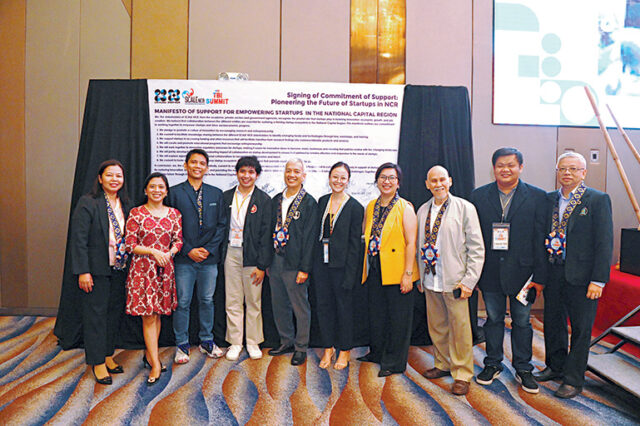Manila-based tech hubs join forces to strengthen Philippine startup ecosystem

Academic institutions, public and private sector organizations, and representatives from local government units (LGUs) in the National Capital Region (NCR) recently formed a consortium to boost the Philippine startup ecosystem through technology business incubators (TBI).
This developed following a memorandum of understanding (MoU) and manifesto of support signed between the parties during the NCR TBI Summit held last Oct. 4 and 5 at Novotel Manila in Araneta City, Cubao, Quezon City.
The Strategic and Collaborative Alliance for Leveraging the Ecosystem of Startups (SCALE) NCR — the TBI consortium funded and supported by the Department of Science and Technology (DoST) — initiated the undertaking with the Technological Institute of the Philippines (TIP) through its Nurture Innovation Technology Revolution Office (NITRO) serving as the project lead.
The manifesto outlined several commitments among 30 signatories, including fostering a culture of innovation, knowledge-sharing between the stakeholders, granting access to funds and resources for startups, and creating educational programs that encourage entrepreneurship.
Members of the consortium also agreed to work together to streamline regulatory processes for startups, develop frameworks for evaluating the impact of their collaboration, explore opportunities for international cooperation, and promote an inclusive and diverse ecosystem.
“By nurturing innovation, sharing knowledge, and providing the necessary resources, we aim to drive economic growth, create jobs, and solve pressing global challenges,” part of the SCALE NCR manifesto read.
The two-day summit gathered ranking officials from higher education institutions (HEIs) that already have existing TBIs in support of the DoST’s call to provide an enabling environment for innovation and technopreneurship.
In her keynote address, DoST-NCR Regional Director Engr. Romelen Tresvalles acknowledged the critical role that educators play in raising socially responsible individuals, especially those who aspire to build their own economically viable and problem-solving startups in the future.
“We recognize that establishing an enterprise that is technology-based is another level of challenge, and with the TBIs around, it eases the burden of our technopreneurs to find the path towards entrepreneurial success,” she said.
The Philippines is currently ranked at 59th in the 2023 Global Startup Ecosystem Index of research center StartupBlink. It has five cities in the index with Manila on top, ranked 95th globally, buoyed by its thriving financial technology (fintech) sector.
With this development, the DoST Philippine Council for Industry, Energy and Emerging Technology Research and Development (PCIEERD) encouraged SCALE NCR to replicate its success in other regions as well in terms of attracting investments and generating revenues.
“It boils down to the quality and attractiveness of the startup… There is an urgent need for all of us to reinforce startup developments in the region. That is our job as part of the ecosystem,” said DoST-PCIEERD Research Information and Technology Transfer Division Chief Russell Pili.
Also present were representatives from the Department of Trade and Industry, Department of Information and Communications Technology, National Innovation Council, and Metropolitan Manila Development Authority/Regional Development Council-NCR, among others.
They conducted learning sessions on how to access funding and investment opportunities, as well as navigate the intricate policies and processes of national government agencies, when it comes to establishing startup businesses.
Representatives from the investment offices of Quezon and Pasig cities, meanwhile, introduced summit attendees to the startup programs of their respective LGUs. Other speakers addressed the prevailing challenges for entrepreneurs amid an evolving business landscape.
Nonprofit organizations such as Philippine Development (PhilDev) and IdeaSpace Foundations, alongside investors and accelerators, shared their pieces of advice and winning strategies to ensure the success of startup ventures in different fireside chats.
The last day of the summit featured different startup founders in the spotlight, pitching their enterprises to all interested investors, including DALA Smart Lockbox of TIP Manila Assistant Professor Engr. Jennalyn Mindoro.
Vice-President for Academic Affairs Dr. Cynthia Llanes signed the SCALE NCR MoU on behalf of TIP together with dignitaries from other participating HEIs and TBIs including Adamson University (AdU), Mapua University, University of the Philippines-Diliman (UPD), University of Santo Tomas (UST), Miriam College (MC), De La Salle University (DLSU) Animo Labs Foundation, Inc., and IdeaSpace Foundation, Inc.
“We are here to be a force of unity, innovation, and growth… Together, we can help SCALE NCR be a beacon for startups and create a fertile ground for new ideas and solutions,” said Engr. Shearyl Arenas, TBI manager for TIP NITRO and lead convenor of the summit.
SCALE NCR involves the following DoST-funded TBIs: TIP NITRO, DLSU Animo Labs Foundation, Inc., UST TOMASInno Center, Mapua Think and Tinker Laboratory, AdU Neo Science and Technology Incubation Center (NEST), UPD UPSCALE Innovation Hub, MC Technology Business Incubator, and QBO Innovation Hub.
















